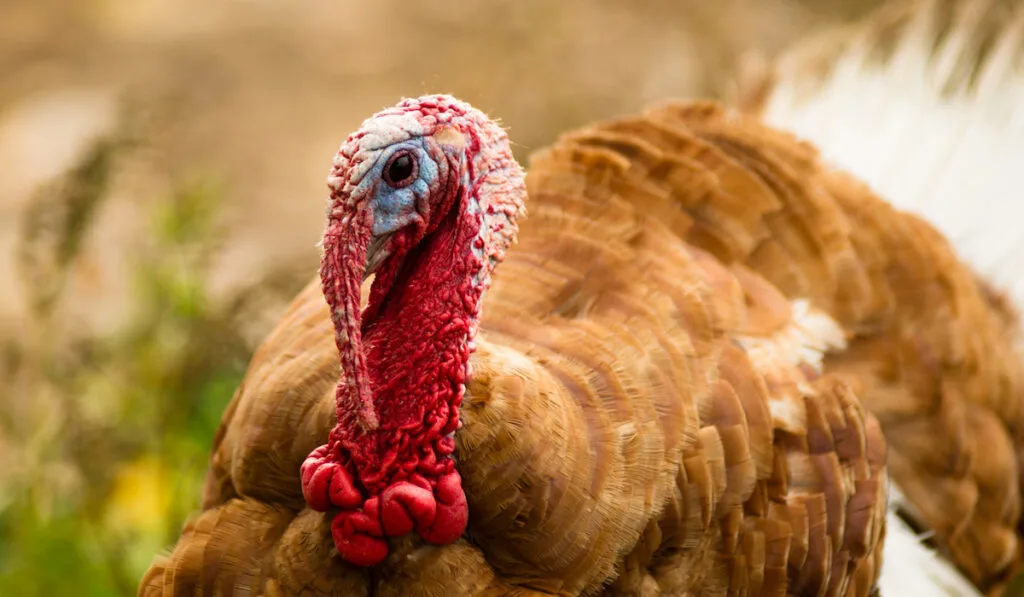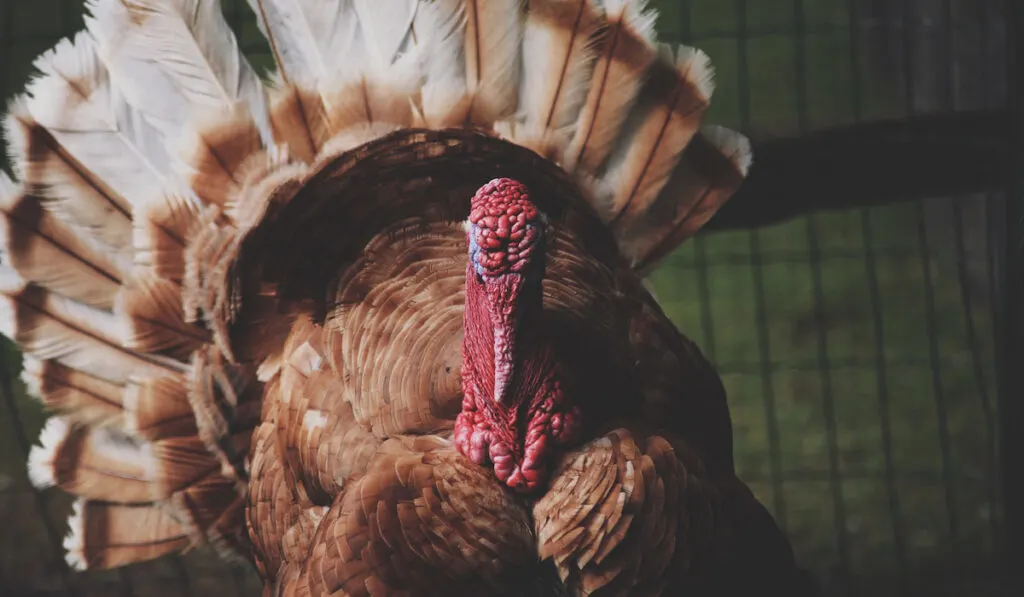Buff turkeys have been around since at least 1874 when the American Poultry Association recognized them in the Standard of Perfection.
The “buff” refers to the beautiful coloring that’s a sort of reddish-brown. These turkeys were prized for their meat and almost were wiped out completely in the early 20th century.
When the New Jersey Department of Agriculture set out to create a smaller breed of turkey, they focused on reviving the buff turkey that was once so popular. Efforts were successful, and the new turkey became known as the “Jersey Buff”.
However, broad-breasted white turkeys remained the most popular breed of turkey in the United States. Now, the Jersey buff turkey is critically endangered.
If you’re interested in raising or keeping Jersey Buff turkeys, there are things you should know to help keep your birds healthy and happy.
We’ve put together a list of interesting facts about Jersey Buff turkeys to make your life easier.

Table of Contents
Jersey Buffs Are on the Small Side
These days, raising turkeys is almost all about meat production. As such, people and farmers want large turkeys that will deliver a ton of nice meat.
Jersey Buff turkeys, on the other hand, tend to be small in size. Most toms will grow to around 20 pounds, and hens will only weigh around 10-12 pounds.
Yes, those are still big birds, but there are other breeds out there with more bang for your buck.
They Have Unique Coloring
Buff turkeys stand out so much because they have beautiful reddish coloring in their body feathers. Their tail feathers are bright white, offering a nice contrast with their body and their red head.
Wing feathers have a nice mix of both colors. Females will usually become lighter colored as they grow older.
They Are Good Egg Producers

A lot of people are keeping Jersey Buff turkeys to try and keep the species alive. That means that they’re not harvesting them right away for meat.
When they become more of a pet, one of the benefits is that you get turkey eggs. Jersey Buffs are generally good egg producers.
They do prefer a low and level place to roost, so if you’re looking to maximize egg production, make sure that extra attention is given to the coop or wherever else they like to lay eggs.
The Jersey Buff Breed Is Rare
There have only been a handful of instances where a new breed of turkey was developed methodically like the Jersey Buff. The large white turkey that’s used frequently for commercial purposes is another example.
Still, the fact that New Jersey was able to develop this bird and that it’s still around is quite an agricultural feat.
Jersey Buffs Are Curious Birds
These turkeys don’t sit around all day. They like to be up and about and will need a good deal of space to feel the happiest. They love to play with toys and can be counted on to go over and check out anything that is new in their area.
You can install toys and other objects to keep them busy. They’re so curious that they often get themselves stuck in fencing or find themselves in interesting places and can’t get back to where they belong.
The First Few Weeks Are Critical
Like most poultry animals, the first few weeks of life are the most fragile. Weather, sickness, and mean adult turkeys make things harder. Baby Jersey Buff turkeys need a lot of care and protection during their first three weeks of life.
They need to stay warm and have constant access to clean water to stay healthy. Even then, you are probably going to lose some chicks even if you’re experienced at raising birds. Unfortunately, it comes with the territory.
They Usually Prefer Circular Enclosures
For whatever reason, Jersey Buff turkeys and many other breeds of turkey prefer circular enclosures. In square enclosures, turkeys tend to crowd into corners and get stressed out navigating the area. Circular fencing keeps them calmer and at ease.
If you can, make your enclosure a big circle to keep them relaxed so they’ll take to living on your property faster.
They Often Nest on the Ground

Jersey Buff turkeys prefer to nest on the ground instead of inside a coop like chickens and other birds. They like long grass that gives them the coverage they are looking for when they go to lay eggs.
Turkey hens, and other poultry, will often nest in the same spot, and it can be hard to get them to change locations. They like how the ground gives them a familiar feel with constant temps that create the ideal conditions for egg-laying.
They Are Social Birds
These turkeys will grow close with human caregivers rather easily. All you have to do is keep the young poults in a nursery where they are safe and can bond with their mother, and they will grow into strong, healthy birds.
They will do well with early handling from you and anyone else who will be around them. Done right, you’ll be able to pick up your turkeys and get up close without spooking them.
Costs Are More Affordable
Because they are smaller than most other turkey breeds, Jersey Buff turkeys will be more affordable to raise and keep.
They also don’t need as much protein in their diets, so you can let them rely on eating vegetables, insects, and other items they can forage on your property. You won’t have to spend as much money on feed as you would with other turkeys.
Herding Them Is Easy
If you’ve ever raised chickens, you know what a pain it can be to get them back in their coop or anywhere else you want to go.
Just when you feel like you’ve got them cornered, they break in all directions and you have to start all over again from the beginning. Turkeys, though, are usually much calmer.
Maybe it’s because they’re bigger, but all you need is a stick to guide them with and they will respond well to what you’re trying to do. Simply hold the stick horizontally and move them in the direction you want them to go. They’ll go happily along.
Jersey Buffs are getting some attention recently because they are endangered birds that people want to keep around. These amazing animals can be a lot of fun to raise, and, when done right, you can get a lot out of having them on your property.
